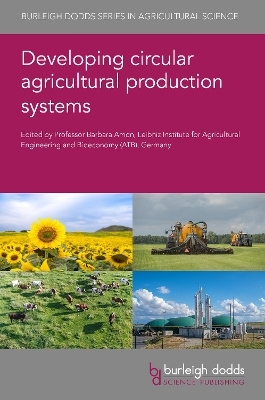
Developing Circular Agricultural Production Systems
Burleigh Dodds Science Publishing Limited (Verlag)
978-1-80146-256-3 (ISBN)
With the agricultural sector pledging to improve its sustainability, there is an urgent need to move away from linear food production models which rely on significant raw material inputs and generate large amounts of residual waste.
Developing circular agricultural production systems reviews the emergence of circular agriculture as an approach to improving the sustainability of the agricultural sector. The book addresses recent advances in understanding and developing closed-loop systems to optimise crop nutrient cycles and resource use, as well as ways agricultural wastes can be recycled back into agricultural production or used as feedstock to produce a range of bio-based materials.
With its comprehensive coverage, the book showcases how to develop circular agricultural production systems, from using crop residues as livestock feed, to producing biogas from livestock manure and manufacturing bio-plastics from agricultural waste.
Professor (UZ) Dr Barbara Amon is an Associate Professor for Environmental Engineering and Agricultural Engineering at the University of Zielona Góra, Poland and a Senior Research Scientist and Board Representative for Research at the Leibniz Institute for Agricultural Engineering and Bioeconomy (ATB), Germany. Professor Amon sits on many panels, including the Intergovernmental Panel on Climate Change (IPCC), UNECE, UNEP and the FAO LEAP Partnership. Dr Víctor Riau currently works at the Sustainability in Biosystems program of the Institute of Agri-food Research and Technology (IRTA). Dr Riau's research is focused on chemical and environmental engineering, organic waste (water) treatment and valorisation, biogas production, nutrient removal and recovery and emission characterisation and mitigation
Part 1 General issues
1. Circular, closed-loop agricultural systems: key principles and challenges: Rolf Meyer, Institute for Technology Assessment and Systems Analysis (ITAS), Karlsruhe Institute of Technology (KIT), Germany;
2. Understanding and developing closed-loop nutrient cycles in crop production: Theun Vellinga, Wageningen University and Research, The Netherlands;
3. Closed-loop combined crop-livestock farming systems: Friedhelm Taube, John Kormla Nyameasem and Friederike Fenger, University of Kiel, Germany;
4. Closed-loop precision farming technologies to optimize resource use: C. Maraveas and T. Bartzanas, Agricultural University of Athens, Greece;
Part 2 Re-using agricultural and other wastes
5. Using crop residues/by-products as livestock feed in a circular economy: Andre F. Brito and Kleves V. Almeida, University of New Hampshire, USA; and Luiz H. P. Silva, Western Kentucky University, USA;
6. Optimizing slurry management: David Fangueiro, LEAF-Instituto Superior de Agronomia-ULisboa, Portugal; Jihane Elmahdi, Wageningen University and Research, The Netherlands; Jared Nyang'au, Aarhus University, Denmark; Stamatis Chrysanthopoulos, LEAF-Instituto Superior de Agronomia-ULisboa, Portugal; Jerke De Vries, Wageningen University and Research, The Netherlands; and Peter Sørensen, Aarhus University, Denmark;
7. Optimizing livestock manure as a biofertilizer and bioenergy source: V. Riau, L. Morey, R. Cáceres, M. Cerrillo and A. Bonmatí, Institute of Agrifood Research and Technology (IRTA), Spain; and A. Robles, BETA Tech Center (UVIC-UCC), Spain;
8. Safe and sustainable use of bio-based fertilizers in agricultural production systems: April Leytem, Robert Dungan, Mindy Spiehs and Dan Miller, United States Department of Agriculture, USA;
Part 3 Co-products
9. Producing biogas from livestock manure and agricultural biomass: R. Fragoso, University of Lisbon, Portugal; D. Hidalgo, CARTIF Technology Center – Circular Economy Area, Spain; and M. Paterson, Kuratorium für Technik und Bauwesen in der Landwirtschaft e.V. (KTBL), Germany;
10. Multi-feedstock biorefineries for converting agricultural wastes and microalgae into co-products: Butch Bataller, University of the Philippines at Los Baños (UPLB), The Philippines; and Sergio Capareda, Texas A&M University, USA;
11. Developing bioplastics from agro-industrial wastes for applications in food packaging: Angela Marchetti, Gaia Salvatori and Lionel Tayou Nguemna, Sapienza University of Rome, Italy; Mattia Grumi, Ahmet Ozan Basar, María Pardo-Figuerez, Jose Maria Lagaron and Cristina Prieto, Institute of Agrochemistry and Food Technology (IATA), Spain; Chiara Marcoaldi, Sapienza University of Rome, Italy and Institute of Agrochemistry and Food Technology (IATA), Spain; Marianna Villano and Mauro Majone, Research Center for Applied Sciences to the Safeguard of Environment and Cultural Heritage (CIABC) and Sapienza University of Rome, Italy; and David Bolzonella, University of Verona, Italy;
12. Developing polyphenols from agricultural wastes: J. Echave, M. Fraga-Corral, S. Seyyedi-Mansour, L. Cassani, P. Garcia-Oliveira, Hui Cao, J. Simal-Gandara and M. A. Prieto, University of Vigo, Spain; and Jianbo Xiao, University of Vigo, Spain and Jiangsu University, China;
Part 4 Case studies
13. Developing closed-loop dairy value chains and tools to support decision-makers: Jack B. Hetherington, University of Adelaide/CSIRO Agriculture and Food/Fight Food Waste Cooperative Research Centre, Australia; Pablo Juliano, CSIRO Agriculture and Food, Australia; and Rodolfo García-Flores, CSIRO Data61, Australia;
14. Aquaponics: challenges and opportunities for commercial application: Lorenzo Rossi, Martina Puccinelli, Ilaria Marchioni, Luca Incrocci, Baldassare Fronte, Carlo Bibbiani and Alberto Pardossi, University of Pisa, Italy;
| Erscheinungsdatum | 11.01.2024 |
|---|---|
| Reihe/Serie | Burleigh Dodds Agricultural Science ; 135 |
| Co-Autor | Prof Rolf Meyer, Dr Theun Vellinga, Prof Friedhelm Taube, Dr John Kormla Nyameasem |
| Zusatzinfo | Illustrations |
| Verlagsort | Cambridge |
| Sprache | englisch |
| Themenwelt | Technik ► Elektrotechnik / Energietechnik |
| Technik ► Umwelttechnik / Biotechnologie | |
| Weitere Fachgebiete ► Land- / Forstwirtschaft / Fischerei | |
| ISBN-10 | 1-80146-256-9 / 1801462569 |
| ISBN-13 | 978-1-80146-256-3 / 9781801462563 |
| Zustand | Neuware |
| Haben Sie eine Frage zum Produkt? |
aus dem Bereich


